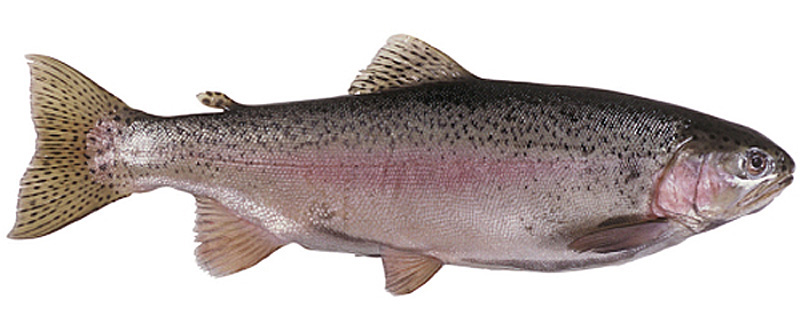
| Scale (tonnes) | 1000 |
| Investment ($ millions) | $7.9 |
| 10 YR NPV - 14% discount rate ($ millions) | $11.7 |
Two main species of trout occur in New Zealand, Brown trout and Rainbow trout. Rainbow trout (Oncorhynchus mykiss) were first introduced to New Zealand in the early 1880s. They are descended mainly from Californian steelhead trout, a rainbow trout that migrates to sea and spend most of their lives there. Although New Zealand rainbow trout do not normally migrate to sea, the species retains the ability to live in seawater.
Brown trout (Salmo trutta) were introduced from Europe in the late 1860s and established themselves rapidly where they were released. They occur throughout the South Island and lower North Island and spread by going out to sea and swimming up other rivers.
 Rainbow trout
Rainbow trout
Rainbow Trout are farmed extensively overseas both in sea pens and in land based farms (ponds, flow through and RAS). They are known to be fast growing (4-6kg in 2-3 years) with excellent FCR’s (0.9 – 1.3) are very hardy and an excellent product, fresh, frozen and smoked. In Denmark RAS grow-out to over 3 kg can be completed in approximately 12 months but these are selectively bred stock with excellent growth performance characteristics.
Strong markets for trout exist in Europe and the USA, with Norway, Chile and the USA having significant levels of trout production in ponds and cages. Like salmon, trout prices have increased in recent years, with a 10% increase observed in Norwegian Trout prices between 2012 and 2013. In 2013 the first sale market price for Norwegian trout exports averaged around NZ$9.50/kg.
Trout farming in New Zealand is currently prohibited under the Conservation Act and Fisheries Act. In the early 1970s salmon and trout farming where both considered, but the government decided to only allow salmon farming. The New Zealand Fish and Game Council, says removing the ban would leave the wild trout stock, a mainstay of recreational freshwater angling, vulnerable to poaching and disease. The debate over trout farming was reignited in 2012 with Sanfords Ltd and Federated Farmers pushing for the long-established ban to be lifted with claims New Zealand is missing out on hundreds of millions of dollars in exports. The decision appears to be political rather than scientifically based and to date no progress has been made towards allowing trout aquaculture in NZ.
Farming trout in RAS units could overcome many of the issues raised since disease risks are reduced and outbreaks could be contained within the RAS should they occur. Additionally farmed stocks would be unlikely to escape to natural waterways. Based on the economic models developed by NPFL, RAS trout farms appear to constitute one of the best opportunities for NZ land based freshwater aquaculture.

Intensive RAS rainbow trout farm in US (owners with background in broiler chicken production)

Design of 3500-4000T trout farm producing 3-4kg fish – egg to harvest (UniAqua Denmark)
Further information on trout farming in RAS systems is available from the following links:
The following generic model simulates the production of trout in an intensive RAS system. The assumptions entered in the model are based on the best information available to NPFL at the time. They will give a general picture of the likely economics and financial viability with this species.
The key outputs from the 10 year generic trout model are:
Based on your specific location, RAS system design and performance specified by the supplier the assumptions may need to be altered for your particular situation. Additionally you may wish to manage production differently i.e. grow the fish to a larger size before sale.
NPFL strongly advise that you seek advice from experts in setting up your own assumptions for your model runs.